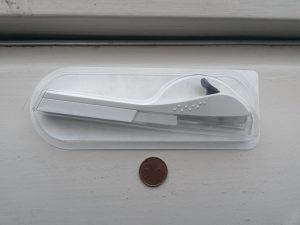Over the years, as women’s priorities have changed, motherhood—which was once many women’s greatest dream—has increasingly taken a back seat, sometimes even being relegated to third place. In response, medicine has been updating and modernizing itself to meet all female needs, offering contraceptive methods adaptable for every type of body. Among the list of contraceptives that have been growing in popularity and seeing gradually increasing demand, the contraceptive implant still raises many questions for women, so we will clarify how it works and how to use it. Considered by the WHO (World Health Organization) to be the safest hormonal contraceptive—even safer than tubal ligation—this method still arouses a lot of curiosity and uncertainty among women due to lack of information.
What is the Contraceptive Implant?
The contraceptive implant, or birth control implant, is a cylinder made of a special plastic called EVA (ethylene-vinyl acetate), about the size of a matchstick, and contains progesterone hormones. Completely flexible and sterile, it measures about 4 cm in length and 2 mm in diameter and is applied with the help of an applicator that must be discarded after use. Its action begins after being placed under the skin, usually in the arm region. Once inserted, the contraceptive implant releases, in small and continuous amounts, daily doses of the hormone.
How Does the Contraceptive Implant Work?
The action of the contraceptive implant begins immediately after it is inserted under the patient’s skin. The area most commonly recommended by gynecologists is the upper arm, which reduces the chances of any local discomfort. In contact with the bloodstream, the contraceptive implant starts to release small daily doses of the hormone progesterone, which prevents ovulation from occurring. It also makes the cervical mucus thicker and more viscous, making it harder for sperm to survive or move toward the uterus, thus preventing the fertilization of the egg. Before deciding to use the contraceptive implant to avoid pregnancy, you need to talk to your doctor, usually your gynecologist. Not all women can use this contraceptive method, so a medical evaluation is necessary and, if needed, some additional tests, along with confirmation that you are not pregnant. Once your gynecologist determines this is the recommended method for you, the date for implant insertion will be scheduled. 
How Is the Contraceptive Implant Inserted?
The contraceptive implant can be inserted right in the doctor’s office, as long as a healthcare professional specialized in this type of contraceptive insertion is present. First, a local anesthetic is administered to the inner side of the arm, and then a special needle-shaped applicator is inserted under the skin. Once removed, the applicator leaves the contraceptive implant inside the skin. The insertion procedure takes about 2 minutes and is completely painless. The contraceptive implant was developed with women’s comfort and effectiveness in mind—and especially as a way to free women from daily birth control, which can be a problem either for those who tend to forget or because their busy routine makes it easy to forget to take the pill as prescribed. Besides this convenience, the contraceptive implant provides long-lasting action, with continuous hormone release into the blood for up to 3 years. Even as a long-acting contraceptive, it can be removed at any time through a quick and simple procedure in the clinic. Removal must be performed by a healthcare professional qualified for the procedure. After removal, the effect of the contraceptive implant is over and the woman may become pregnant at any time.
Side Effects of the Contraceptive Implant
Because it is a hormonal contraceptive, it is common for it to alter the menstrual cycle. Changes in flow volume and temporary absence of menstruation have been reported. Breakthrough bleeding in the first few months of use, the appearance of acne and pimples, changes in weight, and breast tenderness have also been observed. Common side effects of hormonal contraceptives can occur, even if less frequently than with other hormonal methods. Headaches, nausea, loss of libido, mood swings, dizziness, abdominal pain and localized pain near the implant can also occur. All symptoms were observed in the first six months of use and tend to go away over time.
Benefits of the Contraceptive Implant
The greatest benefit of the contraceptive implant is the convenience of not needing daily, monthly, or quarterly maintenance and worry after the application, unlike other methods. But there are other reasons to choose this method, besides convenience:
- Reduces the discomfort of menstrual cramps;
- 99% effective;
- It does not interfere with or interrupt sexual intercourse;
- It can be used while breastfeeding;
- It provides prolonged action for up to 3 years.
Another benefit of the contraceptive implant is that it can be used by women who have a contraindication for estrogen-based contraceptives.
IMPORTANT: Like all hormonal contraceptives, the implant does not protect against sexually transmitted infections, so always use a condom to protect yourself from STIs.
When Should You Replace the Contraceptive Implant?
After the contraceptive implant is placed, it is recommended to have medical follow-up in the coming months to evaluate adaptation and side effects. After the first six months, an annual consultation is advised for continued monitoring. The implant should typically be replaced after three years of use. Removal of the current implant and insertion of a new contraceptive implant is done at the same time in the clinic, in a simple and painless process.
Cost of the Contraceptive Implant
The price may seem high compared to other commonly used contraceptive methods. But considering the duration and all the proposed benefits of the method, it becomes a very viable and satisfactory option. The total cost for both the contraceptive implant and the medical insertion procedure ranges from R$ 900.00 to R$ 2,000.00. If you are unsure about the method and still feel insecure about choosing this contraceptive, talk to your gynecologist to find the best option for your body and your routine. Photo: Vera de Kok











